Metaverse Web 3.0
My GOAL in this Blog is to introduce the Metaverse – a new term made popular when Mark Zuckerberg announced 4Q 2021 that Facebook would be changing its name to Meta.
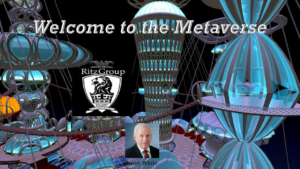
Along with “The Metaverse” came a batch of terms that we will try to define to give you a working perspective of the next Internet Generation – called Web 3.0.
As a part of the process, we will preview some of the history of how we got here and what will happen as we migrate to the Metaverse over the next two decades.
Metaverse The Metaverse, referred to as Web 3.0, is the evolution and integration of today’s Internet Web 2.0 social media, eCommerce, gaming, and Fintech Smart contracts – on the blockchain, into a new VR/AR community experience that will easily enable the exchange of assets person-to-person.
DeFi stands for Decentralized Finance that migrates traditional financial transactions to Smart Contracts housed on the Blockchain. DeFi is the principal technology Paradigm shift to manage asset ownership in the Metaverse economy. In DefI Asset transfer (buy/sell/trade) does not have to pass through today’s traditional third party middleman. It is a Person-to-Person asset exchange.
Cryptocurrency is a new Asset-backed digital currency that can be created, bought and sold with a smart contract on an SEC regulated Exchange. Also called a Fungible Token.
NFT’s stand for Non-fungible Tokens. They are also Crypto Tokens that are created and sold with a Smart Contract on an Exchange, but the ASSET is digital vs. physical and a “one of a kind” collectible that is unique. Proof of Ownership of this unique digital asset determines value.
Blockchain is a technology architecture that uses a Smart Contract to register ownership of an Asset transaction across multiple Authorities vs. today’s one central Authority that can be hacked or compromised.
Now with this basic understanding, lets see how they all play in tomorrow’s Metaverse
No better beginning than to look at Facebook and Mark Zuckerberg’s announcement the Fourth Quarter 2021 they were changing Facebook’s name to Meta.
What did Facebook see? That starts with looking at their evolution from a FREE Social Media Platform to give their members a ‘Voice to the World”. That evolved into promoting your voice by paying an advertising fee. Then Facebook realized that businesses need to also have a voice and would even pay more to “boost” their voice.
That led to the conclusion… that if Facebook could sell products, it could generate even more revenue. In 2020 and 2021, they quietly launched two marketplace selling platforms. Their free Marketplace addressed the local community garage sale audience. Their Product Line based eCommerce provides a full shopping cart with merchant banking that is free to list, but comes with a 5% royalty when you make a sale. More revenue for Facebook. More revenue again when you advertised to “boost” your store placement. Hey, Facebook’s revenue is roughly $86B up some $15B from the previous year.
Facebooks goal is to become the world’s largest eCom platform selling products worldwide to their 2.9 billion members. More value-add to leverage their existing customer base. The problem with this strategy was they will be adding a degree of complexity to their users. Second, today’s eCommerce user expects womb-to-tomb service to include warehousing and delivery.
Does this mean Facebook has to have warehouses, delivery trucks and a Prime Facebook membership?
Perhaps not. The goal is to define a way for member A to sell an Asset to member B directly without going through the traditional eCommerce supply chain. If so, this avoids playing catch-up with Amazon and the majors established in the eCommerce marketplace.
Therefore, Facebook has to fundamentally change today’s buy-sell marketplace. They have the war chest and technology backbone to do it. They will trail-blaze their own unique version of the Metaverse for their 2.9B members. The Pot of Gold for Facebook in the Metaverse is capturing a percentage of the Sales transaction. The challenge is reducing the user complexity and making the NEW experience “simple” and “exciting”.
The rest of the Social Media Communities are also following the same path to leverage their member database. Providing personal voices, advertising to boost, followed by a business voice , Advertising to boost, then eCommerce with migration to buy/sell on the Metaverse in Web 3.0. Example – Pinterest with $2B in annual revenue.
They may use the Facebook Metaverse, develop their own Metaverse within their market niche, or use a Web-3.0 solution developed by – you guessed it…Apple, Google and perhaps Microsoft.
Guess What…Today’s traditional eCommerce bemouths, like Amazon, Walmart and Costco, having mastered eCommerce and their supply chain automation, will focus on extending their customer experience to utilize the latest tools made popular in the Metaverse. They also have the war chest to develop anything they want to in Web 3.0.
Now, let’s stop and review the two architectures to exchange Assets in today’s Web 2.0 marketplace
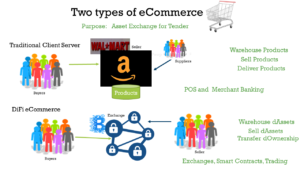
The first is Traditional Web 2.0 eCommerce and merchant banking used by Amazon and other majors. They have automated the consumer physical asset buy/sell womb to tomb. They allow independent suppliers to warehouse, list products and have Amazon ship and deliver. This sets a high bar for social media giants trying to enter eCommerce.
The Second is DeFi eCommerce. The centerpiece here is Blockchain to facilitate the exchange of an asset person-to-person using digital wallets, eliminating the traditional middleman. The first logical market is the exchange of digital Assets. Next, will be person-to-person selling of physical assets, like classic cars or original Artwork.
The challenge is how majors, like Amazon, integrate this buy/sell technology into their traditional customer experience. My perspective is… they will develop niche AR/VR communities, or marketplaces, that once the smart contract is executed – authorize pick and delivery from their warehouse. This selling metaverse community becomes another benefit to Amazon’s suppliers and buyers.
It is expected that for the full Metaverse to roll out will take a decade or more. The key is if we will have one standard, or a different Metaverse from Facebook, Apple, Microsoft, Google – each trying to capture niche markets to leverage their current captive customer base.
Now, on the DeFi side we have a slightly different story. Again, the object is to watch the Social Media Marketplace, the eCommerce space and DeFi Cryptocurrency merge. That’s not to forget the fourth major tech component, called gaming, that must be added to the Metaverse Technology Stack.
The darling, or star in the DeFi world, is the rise of NFT, or Non-fungible assets sold with smart contracts person-to-person on the blockchain. NFT’s have totally automated the buy/sell process of selling AND delivering “digital” products vs. physical products.
This is a major breakthrough on multiple fronts. To prove the point, let me take you back to Circa 2018 when Cryptocurrency broke through as the next big tech revolution.
It’s the story of The RZE Crypto currency token. (RZE)
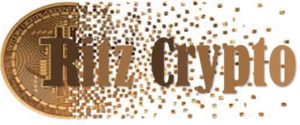
On April 14th 2018, the Atlanta Ritz Group non-profit organization completed our 84 page TAO required to launch the RZE Crypto Currency token backed by our pool of early stage start-up ventures that we believed had the greatest exit ROI. The RZE token was a major investment breakthrough for today’s Private Equity Investors.
Angel investors benefited two ways. 1) If the price of the RZE token went up, or 2) if the valuation of the Venture pool went up. More importantly, they could Sell their RZE token at any time vs. waiting 7 to 15 years for the traditional PEI Start-Up to exit.
We shelved the project because Crypto currency Tokens were just too early in the game. The SEC came out with new rules requiring Cryptocurrency to be backed with an asset. Their regulations regarding Exchanges to mint and trade were unclear. Creating on the Blockchain, smart contracts were just emerging with many unknows and very expensive. The sum total was… just too much early investor risk
Oh, how far we have come in four years. What blew me away was discovering that, today we have the technology in place today to mint, list and trade your NFT in less than 15 minutes with a smart contract on the Blockchain in not one, but several Exchanges.
That is a far cry from the RZE 2018 experience. This, for me, is the Tipping Point signaling that NFT has a chance for success. The paradigm shift is establishing the value of a pure digital asset vs. today’s physical asset valuations. Yes, it is the Wild-Wild West and there will be fraud with early big time winners and losers.
NFT emergence also paves the way for emerging AR/VR/XR digital communities like Decentraland and the Sandbox. There is the real you and for many there will be a digital you. Shopping is, after all, all about entertainment.
Steps to Create your NFT For me – the proof item for any possible NFT Success.
Step #1 is to create your Digital Art, and you would be surprised at the number of computer generated programs to help you do that, or create computer generated variances to create a Collection of “unique” works. It is also unbelievable how may traditional paint brush artists use the computers to create their masterpiece. It is a new world for Artists. Digital meets physical in Art.
Step #2 is picking your Listing/Trading Exchange. There are several with OpenSea being the most popular. Others represent more niche markets – like Bitski for fashion. Some are using alternative blockchain protocols to reduce Ethereum transaction fees – called GAS.
Step #3 is fill out the Application that includes a Smart Contract, number of each digital asset to be minted, or a collection. Finally, enter your go to market pricing. You can set your price, or place your NFT out for bid.
Step #4 is paying for listing your NFT using your digital wallet – like Metamask which you must pre-load with Ether purchased at some market price. Ball park pricing for your very own NFT, depending on the marketplace price for Ether, is around $100 to $300 dollars.
Step #5 is viewing your NFT on the Exchange Marketplace. This is where others find your digital work of Art. Other NFT Marketplaces will spring up to provide specialized venues.
Step #6 is promoting your NFT on Social Media (Twitter) or others. Key to ramping-up NFT success is based on your followers that you can promote. If your NFT works in an AR/VR experience like Decentraland – then this also drives potential new buyers.
Asset Classes
Now, the Wild-Wild-West Metaverse has divided our Assets into two classes – Fungible and Non Fungible
Fungible tender is cash, stocks/Bonds, Bitcoin and Crypto Tokens – all asset based and SEC regulated. Fungible means the value of the asset across its ownership is the same. A US dollar has the same value to all of its users. The market value can change, but this impacts ALL owners of a fungible asset.
Non-Fungible (NFTs) consists of digital Assets, also SEC regulated, that are ALL unique with ownership registered using a smart contract on the Blockchain. This NEW digital asset can be anything from Art, Sports, Real Estate, Cars, TickTok videos and more. The market determines the valuation of a digital asset.
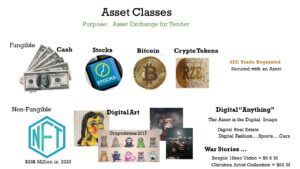
Wealth Management Portfolio
Tomorrow your wealth management portfolio will include the following: 1) Your Public Traded Stocks/Bonds/Futures, 2) Private Equity Stocks, 3) DeFi Traded Crypto and DeFi Traded NFTs. Same GOAL as today – balance your portfolio based on risk/reward.
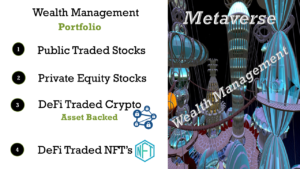
NFT Metaverse Marketplace. Who is going to do this?
- Z-Linals to age 35- especially if they have a social media following. This includes media stars. The Gold Rush is a $300 to $500 investment can rake-in millions.
- Digital Brokers that provide NFT turnkey services to ICONS/Celebrities with fans and create NFTs and even specialized marketplaces for niche NFT’s.
- Social Media giants with millions of fans, that are migrating to eCommerce and need to leverage their member base, plus also reduce the complexity of their eCommerce strategies. Their low hanging fruit, is one-to-one digital asset exchange. Again, their GOAL is a percentage of the sale.
- e-COM Majors need to find niches they can leverage their suppliers and provide new Metaverse market opportunities, much like when they integrated warehouse and delivery services. This recognizes their current suppliers don’t have the time, or skills, to position their products in the Metaverse – more precisely in multiple Metaverse niche communities.
Final Thoughts…
Social Media majors, Google and Apple have the war chest of funds to create and shape the Metaverse anyway they want to – and will do so.
The second major “must watch” is… the transition from the exchange of digital assets to physical assets on the Blockchain. This will be driven by the eCommerce Giants, like Amazon, who also have the war chest of funds to shape their Metaverse market in their best interests and at an accelerated pace.
So, the Metaverse Web 3.0 should be a fun watch as the Giant Mega techs cobble together the best of social media, ecommerce, blockchain Smart Contracts into gaming-based communities to simplify and excite consumer purchases in both traditional and NEW one-to-one asset exchange.